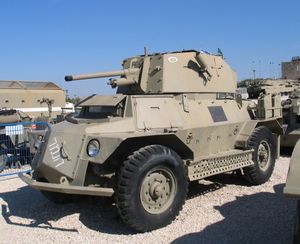Marmon-Herrington Armoured Car
| Marmon-Herrington Armoured Car Mk IV / Mk IVF | |
|---|---|

Marmon-Herrington Mk IVF ha-Namer ha-Norai (The Terrible Tiger) in Yad la-Shiryon museum, Israel.
|
|
| Type | Reconnaissance car |
| Place of origin | Union of South Africa |
| Service history | |
| Wars |
Second World War Indonesian National Revolution Turkish invasion of Cyprus Rhodesian Bush War 1948 Arab–Israeli War |
| Production history | |
| No. built | 5,746 (1940-1944) |
| Specifications | |
| Weight | 6.4 tonnes |
| Length | 15 ft (5.51 m) |
| Width | 6 ft (1.83 m) |
| Height | 7 ft (2.29 m) |
| Crew | 3-4 |
|
|
|
| Armour | up to 20 mm |
|
Main
armament |
QF 2 pounder gun. |
|
Secondary
armament |
1 or 2 x 7.62 mm Browning machine gun. |
| Engine | Ford V-8 petrol. 95 horsepower (71 kW) |
| Power/weight | 14.2 hp/tonne |
| Suspension | wheeled; 4 x 4 drive |
|
Operational
range |
200 miles (322 km) |
| Speed | 50 mph (80 km/h) |
The Marmon-Herrington Armoured Car was a series of armoured vehicles that were produced in South Africa and adopted by the British Army during the Second World War.
In 1938 the South African authorities began funding development of a new armoured car for the Union Defence Force. The outbreak of the Second World War led to a vehicle based on a Ford 3-ton truck chassis. As South Africa then lacked a developed automotive industry, many components of the vehicle had to be imported. Chassis components were purchased from Ford Canada and fitted with a four-wheel drive train produced by the American company Marmon-Herrington (hence the designation), UK-made armament (with the exception of the U.S.-made Browning machine gun) and armour plates produced by the South African Iron & Steel Industrial Corporation, ISCOR. Final assembly was done by the local branch of the Dorman Long company among others
The first version, the "South African Reconnaissance Vehicle" Mk I, entered service in 1940. It was a long wheelbase four wheeled chassis with drive to only one axle. It was armed with two Vickers machine guns: one in a cylindrical turret and the other in the left hand side of the hull. There were two large access doors in the rear. It saw a brief action against the Italian forces in the Western Desert and thereafter relegated to training use.
The Mk II had a shorter wheelbase than the Mark I and four wheel drive by using a kit from Marmon-Herrington that offered a front-driven axle. It was known in British service as Armoured Car, Marmon-Herrington Mk II. The Mark I continued in production (until the end of 1940) while supply of parts from the United States was resolved. Mark II, "Middle East Model" denoted the vehicles serving with British forces in the North African campaign. This variant was fitted with a Boys anti-tank rifle and a single coaxial Bren light machine gun. A second model intended for sub-Saharan deployments was armed with twin Vickers machine guns.
...
Wikipedia
